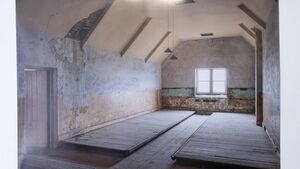Most in Athy Workhouse during Famine were children

The interior of Athy workhouse Photo: Brian Cregan
DUE to illness, I missed the Famine Commemoration Ceremony in St. Mary’s Cemetery on the third Sunday of May. I understand it was well-attended and I want to thank Fr Liam Rigney and Rev Conor O’Reilly for leading the prayers at the ceremony.
I am reminded that approximately four years ago, I approached the then county council Chairman, Mark Stafford, regarding the desirability of installing a memorial in St Mary’s Cemetery to those who died in the Athy Workhouse during the Great Famine. He agreed and I understand the county council members also approved.
However, so far nothing has happened but in the meantime Clem Roche has done superb work in identifying the names of the children, women and men who died in the Workhouse and are buried in unmarked graves in St Mary’s.
It strikes me that Clem and Eddie Lawler and their colleagues who did such a good job of erecting a superb World War 1 memorial in St Michael’s Cemetery would take up the challenge of erecting a similar type of memorial in St Mary’s Cemetery.
What better way of commemorating those who died in the Famine than to use Clem Roche’s research to list their names on the cemetery memorial. I have spoken with Clem who is the current chairman of Athy Historical Society, and he has agreed to undertake the task.
In December 1843, work on the workhouse in Athy was completed. The first inmates were admitted to the workhouse on 9 January 1844. The admission records showed that five men, four women, 10 boys, five girls and one infant were categorised as paupers on their admission.
A week later, a further six men, 15 women, 13 boys, five girls and two infants were admitted to the workhouse. Admissions increased during 1846 and in the last week of November 616 inmates were registered. In the weekend of 5 December 1846, three inmates died. Seven more inmates died the following week.
For adult inmates, whether men or women who were more than 15 years of age, breakfast consisted of 7oz of oatmeal and one pint of milk. Dinner consisted of 3½ lb of potatoes and one pint of buttermilk. Children between 3-15 years of age were provided with a breakfast of 4oz of oatmeal and a half pint of sweet milk.
Dinner for them consisted of 2 pounds of potatoes, with a half pint of buttermilk. For supper they received a ¼ lb bread and a half-pint of buttermilk.
Infants under 3 years of age received 4oz of oatmeal at breakfast time, with a half-pound of bread and one pint of sweet milk.
In November 1846, the Society of Friends established a Central Relief Committee which was involved in the opening of food kitchens throughout the country. Fr Thomas Greene, CC Athy, received a grant of £15 from the Quaker Committee for the poor of Athy.
In January 1847, Dr Thomas Kynsey, medical officer of the workhouse, advised that 652 inmates were accommodated in the building which had been constructed to house 600.
In December 1846, 18 inmates died in the workhouse. The following month 60 inmates died, even though the total inmate population had not increased. In February 1847, the Board of Guardians advised that it had provided additional accommodation for 30 inmates by fitting up sheds, once used as straw and turf stores.
One month later accommodation for a further 50 inmates was provided by appropriating sheds in the boys and girls wards for use by children under four years of age. On 10 April, 34 additional inmate places were provided increasing the workhouse accommodation limit to 714. Within seven days the inmate intake exceeded 700 and that same week 10 persons died in Athy Workhouse.
During the first four months of 1847, the total number of workhouse inmates varied between 583 and 704 and deaths averaged 10 per week.
On 26 February 1847 the legislation which provided for the operation of soup kitchens in Ireland, was passed.
Within the Athy Poor Law Union area soup kitchens were operated in 12 of the 14 electoral divisions.
The local Relief Committee which managed the soup kitchens consisted of local members of the Board of Guardians and in Athy included the local Parish Priest Fr James Lalor and the Church of Ireland Rector Rev Frederick Trench.
The food dispensed from the local soup kitchen was strictly rationed. Adults received one lb of bread or one lb. of biscuits or 1 lb. of meal or flour.
If a boiler was available to the local Relief Committee one quart of soup with a portion of meal was provided with 6 oz. of bread, biscuit or meal. Children under 9 years of age received half the adult ration.
In July 1847 it was announced that the soup kitchens would be discontinued in August.
When the soup kitchens in the Athy Poor Law Union area operated the highest numbers of persons supplied with food in any one day was 16,365, which represented 34 per cent of the total population of the area.
Within the Poor Law Union area the highest percentage dependency on soup kitchen rations was in the Ballyadams electoral area where it was almost 100 per cent.
In the Athy electoral division, which included the town of Athy, the highest recorded number to receive help in the soup kitchens in any one day represented 22.1 per cent of the population.
During the autumn of 1847 two ancillary workhouses were opened in Athy due to overcrowding in the workhouse. Workhouse inmates in February 1848 totalled 1254.
The potato failure had its greatest effect on families with young children. As a result, the majority of the workhouse inmates in Athy were children. During the Great Famine a total of 1,205 persons died in Athy Workhouse and the adjoining fever hospital. They lie buried in unmarked graves in St. Mary’s Cemetery.
A memorial recording the names of our famine dead would be a dignified response to decades of neglect. We must remember them.






